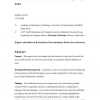151 search results - page 6 / 31 » Using trust and risk in role-based access control policies |
107
click to vote
SP
2007
IEEE
15 years 5 months ago
2007
IEEE
In several distributed systems a user should only be able to access data if a user posses a certain set of credentials or attributes. Currently, the only method for enforcing such...
130
click to vote
ECOOPW
1998
Springer
15 years 3 months ago
1998
Springer
PrincipalDomain is an administrative scoping construct for establishing security policies based on the principals invoking object services that may entail objects moving around a ...
INTR
2007
14 years 11 months ago
2007
Purpose – This paper seeks to investigate how the concept of a trust level is used in the access control policy of a web services provider in conjunction with the attributes of ...
137
Voted
ICDCS
2002
IEEE
15 years 4 months ago
2002
IEEE
Distributed Role-Based Access Control (dRBAC) is a scalable, decentralized trust-management and accesscontrol mechanism for systems that span multiple administrative domains. dRBA...
ITRUST
2005
Springer
15 years 5 months ago
2005
Springer
The importance of risk in trust-based systems is well established. This paper presents a novel model of risk and decision-making based on economic theory. Use of the model is illus...


